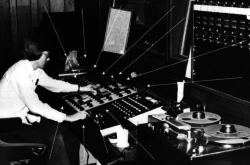So you’ve dialed in the perfect mix – the vocal sits with the track, the bass and kick drum are playing nicely, and the song feels done. But if you’re not printing the following six mixes/stems, then you might be hurting yourself down the road.
1. Master Mix
A master mix is clearly an important mix to print. This will be the mix that you release, publish online, and use for most of your distributing purposes.
It’s important to print a “full-res” version at the highest resolution you mixed at (for bit-depth and sample rate). I usually record/mix/master 24-bit / 48kHz WAV files.
Then, print one at “CD quality” – 16-bit / 44.1kHz WAV. In most cases, this is going to be the highest resolution that you distribute.
Finally, an mp3 can be really helpful if you’re going to distribute your music online. I like to print an mp3 at 320 kbps in order to keep the maximum resolution while still keeping the file small enough to share online.
2. Instrumental
An instrumental mix is one without any vocals. This is a really important mix if your music is every used in a sync placement (TV show, film, commercial, YouTube video, etc.).
For this mix, I generally will print a 16-bit / 44.1kHz WAV version.
3. Individual stems
Stems are a little tricky to define in some cases, but a good rule of thumb is: if you were remixing the song, which stems would you want to have access to? Here are the stems I go with most of the time:
- Lead Vocal Lead
- Vocal Background
- Vocal Synth Stem
- Pad Stem
- Bass Stem
- Drum Stem
- FX Stem (Risers, White Noise, etc.)
I find that this gives me enough flexibility to be able to remix a track / have another producer remix the track without having to kill myself overprinting 30 different stems.
Because of my mixing workflow, it is pretty easy to print these different stems. I set up Aux tracks for each stem and route the individual tracks to their appropriate Aux tracks. This way, I can simply solo each Aux track, hit “render”, and repeat.
Again, 16-bit / 44.1kHz WAV is a great format for these stems, although some people like to render at the full resolution that they recorded in.
4. A cappella
An a cappella track is slightly different than a stem in that it includes the Lead Vocal and Background Vocals for the track. This is a great mix to print in the event that you want to have another producer remix your track with an entirely new beat, but still want to have your vocals as you produced them.
While less requested than an instrumental track, this can also be helpful for sync placements. It allows the re-recording mixer the ability to mix in the vocal lines as she pleases, rather than having to do the much more tedious task of crossfading an instrumental and a final master mix.
16-bit / 44.1kHz WAV is a fine resolution for this mix.
5. Vocal up / Vocal down
The Vocal Up / Vocal Down mix can be a huge time-saver if you’re going to be mastering your tracks OR sending them off to be mastered. With all of the compression and processing that happens in mastering, you never know what is going to happen to the vocal. It could become far too prominent in the mix, or it could get buried.
These safety mixes provide a fast and easy way to try out different possibilities. Most mastering engineers will request these mixes to be between 1.5 dB +/- and 3 dB +/-. (This means that you would turn the vocal up between 1.5 dB and 3 dB for the vocal up mix, and down between 1.5 dB and 3dB for the vocal down mix.)
Even if you’re mastering your own music, this can be a great time saver. Rather than having to re-open up your mix session to make a small tweak to the vocal level, plan ahead and make it easy to try out which feels best after you’ve applied the mastering processing.
For these mixes, print at “full-res” (whatever your master mix is printed at), since it will likely be used in the mastering process.
6. TV Track
Ever wonder how the artists on talk shows sound so good when they perform? They’re performing to TV tracks in most cases. A TV track is a mix that has everything except the lead vocal. This mix is exactly what its name states: live performances on TV where the lead vocalist would sing only the lead vocal lines.
This is something that is very helpful to plan ahead for. You never know when you’re going to need it, but when you do, you’ll be glad you can simply grab the file rather than having to re-familiarize yourself with a mix you did previously, potentially years ago. 16-bit / 44.1kHz is a good resolution for this mix.
Those are the six mixes I like to print as I complete every track. By doing this, I’ve created a better and more complete archive of my work, while also making things easier whenever I do need to go back and look something up.
Are there any mixes that you like to print that I didn’t mention here?
And if you are not yet done with your mix and are feeling stuck, check out this new mixing toy from iZotope.
Explore royalty-free one-shots, loops, FX, MIDI, and presets from leading artists, producers, and sound designers:
October 30, 2017



